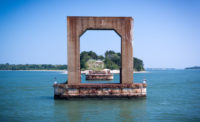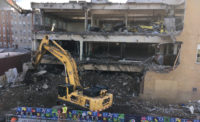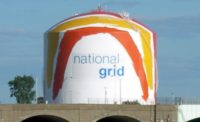A high-pressure bridge-rehabilitation project continued to wreak havoc for Boston-area commuters on July 31 as crews installed 11 new steel girders on the eastbound side of the heavily traveled Commonwealth Avenue Bridge spanning Massachusetts I-90 and commuter rails near Boston University.
The project team is working under the gun as commuters contend with road closures, lane reductions and the closure of the Boston University bridge during an intensive 18.5-day shutdown period so crews can work nonstop. Some 30,000 drivers cross the structure known colloquially as the "Comm Ave. Bridge" each day. An additional 26,000 Massachusetts Bay Transportation Authority Green Line passengers cross the bridge as well, while between 128,000 and 145,000 drivers travel beneath the bridge on Massachusetts I-90 each day.
In the works since 2011, the bridge installation started on July 26 after major bridge components were fabricated off-site so crews could assemble them in place in a matter of weeks.
The $82 million project is expected to be completed by Aug. 14.
Crews will ultimately replace the entire superstructure of the deteriorating 52-year-old bridge with improvements, including utility relocations, dedicated bike lanes and extensive pedestrian upgrades. This follows a two-year rehabilitation of the substructure completed last year.
Acting MassDOT Highway Administrator Jonathan Gulliver said at a press conference on July 29 that "construction is running on schedule," and that held true as of early Sunday morning, when demolition on more than two-thirds of the bridge's eastbound side was completed.
MassDOT is partnering with general contractor Walsh Construction on the design-build project to replace the structurally unexciting but logistically critical deck-and-steel-beam bridge.
The first phase of the two-phase project involves replacing the bridge's eastbound lanes and the MBTA Green Line track deck. The westbound portion will be completed next summer, with final completion slated for December 2018, according to MassDOT.
"Phase 1 is more extensive since we have to take up Green Line track, replace the girders underneath and rebuild the whole Green Line in the area of the bridge," says Michael McGrath, construction deputy chief engineer for the MassDOT highway division.
The team has been focusing on "managing logistics surrounding the construction site since the project impacts all modes of transportation," Gulliver says.
He also noted that, "To minimize risk, we are doing more of the fit-up of the bridge elements on the ground and using a bigger crane than we would have normally deployed to get everything up into place in larger pieces rather than doing the fit up on the bridge."
Accelerated Bridge Construction methods are helping shorten the duration of onsite construction. Two 400-ton hydraulic cranes will be operating on the bridge and one 440-ton hydraulic crane down on I-90, says Chuck Labbee, MassDOT resident engineer. Similar to the "Fast 14" bridge replacement project that replaced 14 Medford, Mass., bridges in 2011, self-propelled modular transporters are being used to move heavy bridge structure.
The bridge girders are 90 ft to 150 ft in length and 36 in. to 80 in. in depth, weighing 30 to 80 tons, with some delivered in pairs weighing up to 160 tons, Labbee says.
Walsh will use precast concrete elements and rapid-set concrete, and construct the deck panels off-site for positioning when needed.
Sequencing for both eastbound and westbound phases of work includes de-energizing the Green Line catenary, removing cables and existing track, using an I-90 crossover to move traffic into the westbound side of I-90, demolishing existing spans and installating new spans over commuter rail and I-90 eastbound.
While originally scheduled to begin in summer 2016, McGrath says the project was delayed due to fabrication factors and the decision to avoid a fall start date to avoid disrupting returning university students.










Post a comment to this article
Report Abusive Comment